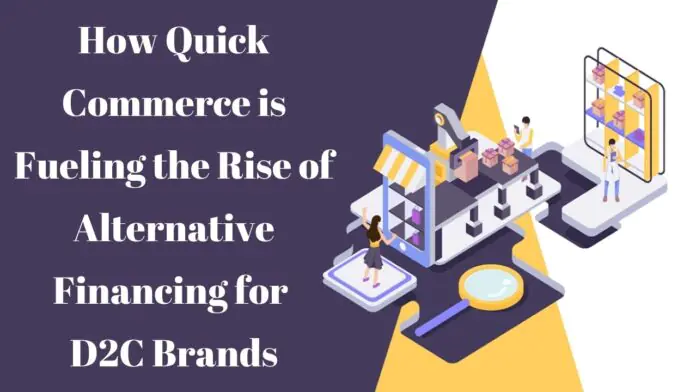The rapid growth of quick commerce platforms like Blinkit, Swiggy Instamart, and Zepto is transforming how consumers shop, and in turn, reshaping the financial landscape for direct-to-consumer (D2C) brands. To keep up with the demand for faster deliveries and expanded inventories, D2C brands are increasingly turning to alternative financiers like Recur Club, GetVantage, Velocity, and Klub. These platforms offer innovative debt solutions tailored to the fast-paced quick commerce ecosystem, enabling brands to secure the working capital they need to stay competitive.
In this blog, we’ll explore how quick commerce is driving the demand for alternative financing, the challenges and opportunities it presents, and what this means for the future of D2C brands in India.
Why Are D2C Brands Turning to Alternative Financing?
The Quick Commerce Boom and Its Impact on Working Capital
Quick commerce platforms have revolutionized consumer shopping habits, offering deliveries in as little as 10-15 minutes. This has created a surge in demand for D2C brands to maintain larger inventories and faster stock replenishment at dark stores.
According to Recur Club, a Delhi-based debt marketplace, the demand for debt financing has grown 3x in the last four months, with over ₹150 crore disbursed to consumer startups. Founder Eklavya Gupta notes, “The last few months have seen almost 3x growth in debt financing requirements, proportionate to the growth of quick commerce.”
Key Insight: Quick commerce is driving D2C brands to seek larger working capital to meet rising consumer expectations.
How Are Brands Using Alternative Financing?
D2C brands are primarily using these loans for two purposes:
- Inventory Expansion: To ensure faster stock replenishment at dark stores.
- Marketing Campaigns: To boost visibility and sales on quick commerce platforms.
For instance, Pilgrim, a beauty and personal care brand, has seen its working capital requirements double in the last 12 months due to its quick commerce business. Founder Anurag Kedia explains, “Working capital is a priority for any consumer business—quick commerce and otherwise.”
Key Insight: Alternative financing helps brands scale rapidly by addressing critical needs like inventory and marketing.
What Are the Benefits of Alternative Financing?
Faster Access to Capital Without Equity Dilution
Traditional lenders like banks and NBFCs often have lengthy approval processes and conservative lending criteria, making it difficult for startups to secure timely funding.
Alternative financiers like Recur Club and GetVantage offer revenue-based financing models, where brands can secure up to 2-4x their monthly sales without diluting equity. Recur Club typically takes 15-30% of a brand’s monthly or quarterly sales, depending on the arrangement.
Key Insight: Alternative financing provides a quick and flexible solution for startups to access capital without giving up equity.
Tailored Solutions for the Quick Commerce Ecosystem
The rise of quick commerce has created unique challenges for D2C brands, such as managing cash flow while scaling revenue at lightning speed.
Ninad Karpe, founder of 100X.VC, explains, “New-age fintech players are tailor-made for this dynamic ecosystem. They offer fast, flexible, and innovative financial solutions that align with the evolving needs of modern startups.”
Key Insight: Alternative financiers are designed to meet the specific needs of startups operating in the quick commerce space.
What Are the Challenges of Alternative Financing?
High Interest Rates and Limited Cash Flow
While alternative financing offers quick access to capital, it comes with its own set of challenges. Interest rates on these loans can sometimes exceed 20%, making it an expensive option for young startups with limited cash flow.
Key Insight: Brands must carefully evaluate the cost of financing to ensure it aligns with their growth strategy.
Dependency on Quick Commerce Platforms
As brands scale on quick commerce platforms, they become increasingly dependent on these channels for revenue. This can create risks if consumer behavior shifts or if platforms change their policies.
Key Insight: Diversifying sales channels can help mitigate risks associated with over-reliance on quick commerce.
What Does the Future Hold for D2C Brands?
A Growing Market Opportunity
The quick commerce market in India is projected to reach ₹8.3 trillion by 2029, creating immense opportunities for D2C brands. Bhavik Vasa, founder of GetVantage, estimates that consumer brands will require ₹1.66 trillion in credit to seize this opportunity.
Key Insight: The quick commerce boom is just beginning, and D2C brands that adapt quickly will thrive.
The Role of Technology and Innovation
As the quick commerce ecosystem evolves, brands will need to leverage technology and innovation to stay competitive. This includes adopting data-driven inventory management, AI-powered marketing tools, and sustainable packaging solutions.
Key Insight: Innovation will be key to unlocking the full potential of quick commerce for D2C brands.
FAQs About Quick Commerce and Alternative Financing
What is quick commerce?
Quick commerce refers to the delivery of goods, primarily groceries and daily essentials, within 10-15 minutes through platforms like Blinkit, Swiggy Instamart, and Zepto.
Why do D2C brands need alternative financing?
D2C brands need alternative financing to secure working capital for inventory expansion, marketing, and other growth initiatives, especially in the fast-paced quick commerce ecosystem.
How does revenue-based financing work?
Revenue-based financing allows brands to secure loans based on their monthly or quarterly sales, with repayments tied to a percentage of future revenue.
What are the risks of alternative financing?
The risks include high interest rates, dependency on quick commerce platforms, and potential cash flow challenges for young startups.
Conclusion: Embracing the Quick Commerce Revolution
The rise of quick commerce is reshaping the D2C landscape, creating both challenges and opportunities for brands. By leveraging alternative financing solutions, D2C brands can secure the working capital they need to stay competitive in this dynamic ecosystem.
As the market continues to evolve, brands that embrace innovation, diversify their sales channels, and carefully manage their finances will be well-positioned to thrive in the era of quick commerce.


